Strangers, Sinners, and Survivors: The Women of ‘The Strangers’ Universe [Fatal Femmes]

Few modern horror movies have destabilized the genre like The Strangers. Bryan Bertino’s 2008 home invasion film chronicles one hellish night as a doomed couple is stalked and tormented by a trio of masked attackers. Stars Liv Tyler and Scott Speedman front the film as the ill-fated couple, but the Strangers who converge on their vacation home have become genre icons symbolizing random and senseless violence. Though they appear to act on behalf of the ominous Man in Mask (Kip Weeks), Pin-Up Girl (Laura Margolis), and Dollface (Gemma Ward) use iconic images of femininity to destroy a woman already struggling with the patriarchal ideal.
These killers return in Johannes Roberts’ neon sequel The Strangers: Prey at Night. This time roaming an abandoned trailer park, Pinup (Lea Enslin), Dollface (Emma Bellomy), and the Man in the Mask (Damian Maffei) target a mother trying to redirect her troubled daughter. As two horrific nights unfold, these five women tangle with the concept of feminine sin and idealized beauty in the modern world.
Their Story
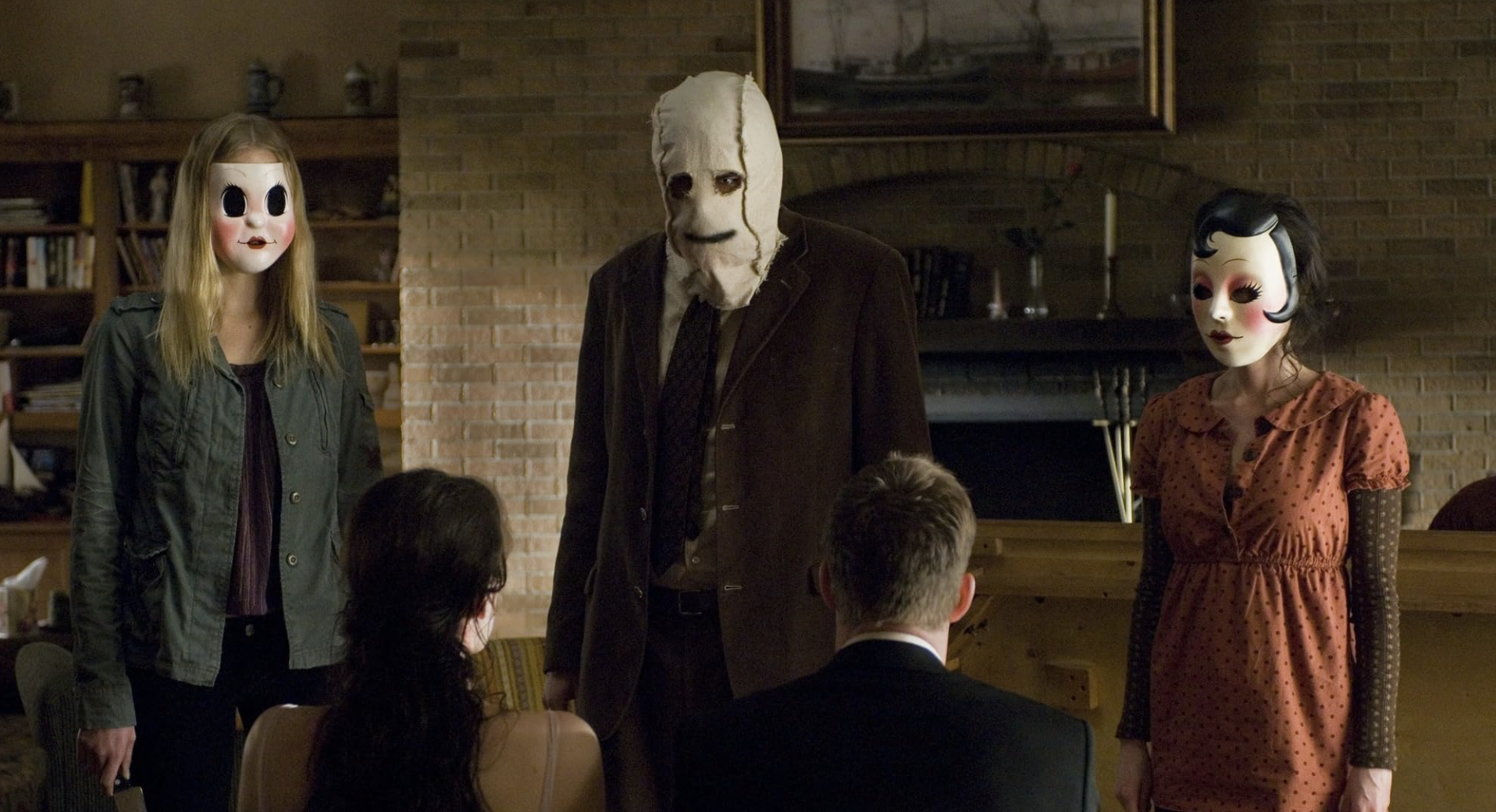
We first meet the Strangers shrouded in darkness. James (Speedman) and Kristen (Tyler) are trying to reconnect after a devastating date when they’re startled by a late-night knock at the door. A young woman stands on the porch, fully bathed in shadows, asking if someone named Tamara is home. This is most likely Dollface unmasked, her question marking the confused couple for death. She later returns with her two partners in crime to systematically terrorize this unfortunate pair before stabbing them hours later in the bright morning light. They leave James and Kristen for dead and then casually drive away, making plans for another night of murderous fun.
The next time we see Dollface (in The Strangers: Prey At Night), she’s broken into another home. The elderly managers of an off-season trailer park become the next pawns in her sinister game. The trio stumbles upon a new batch of victims when the couple’s relatives stop by for the night. Dollface once again stands in the shadows after disabling the porch light to hide her identity. After asking for Tamara, she runs off into the night leaving Mike (Martin Henderson) and Cindy (Christina Hendricks)—themselves parents to kids her age—to wonder if she’ll be alright by herself. The answer is both yes and no.
Over the next few hours, the empty campground becomes a battlefield as the Strangers elevate their eerie tricks. With more ground to cover and more victims to kill, Pin-Up Girl and Dollface increase the severity of their violence. But eventually, they die at the hands of resourceful teen siblings Kinsey (Bailee Madison) and Luke (Lewis Pullman).
Their Weapons
The female Strangers use fairly typical weapons found in the homes they attack. When not lurking in the shadows, they can usually be seen brandishing knives or blunt objects to cause physical harm. Pin-Up Girl also takes a turn behind the wheel of a pick-up truck, though this is usually the domain of the Man in the Mask. However, these creative killers employ an impressive arsenal of non-traditional tactics to unnerve and unsettle their terrified victims. They sneak into the house undetected and move things around, causing Kristen to wonder if she’s losing her mind. From dripping red smiley faces painted on doors to malfunctioning fireplaces and unplugged phones, the Strangers delight in causing mental anguish well before they strike the first blow. We don’t see exactly who sets up which scare, but it’s logical to assume that Dollface and Pin-Up Girl are equally responsible for this ghoulish gaslighting.
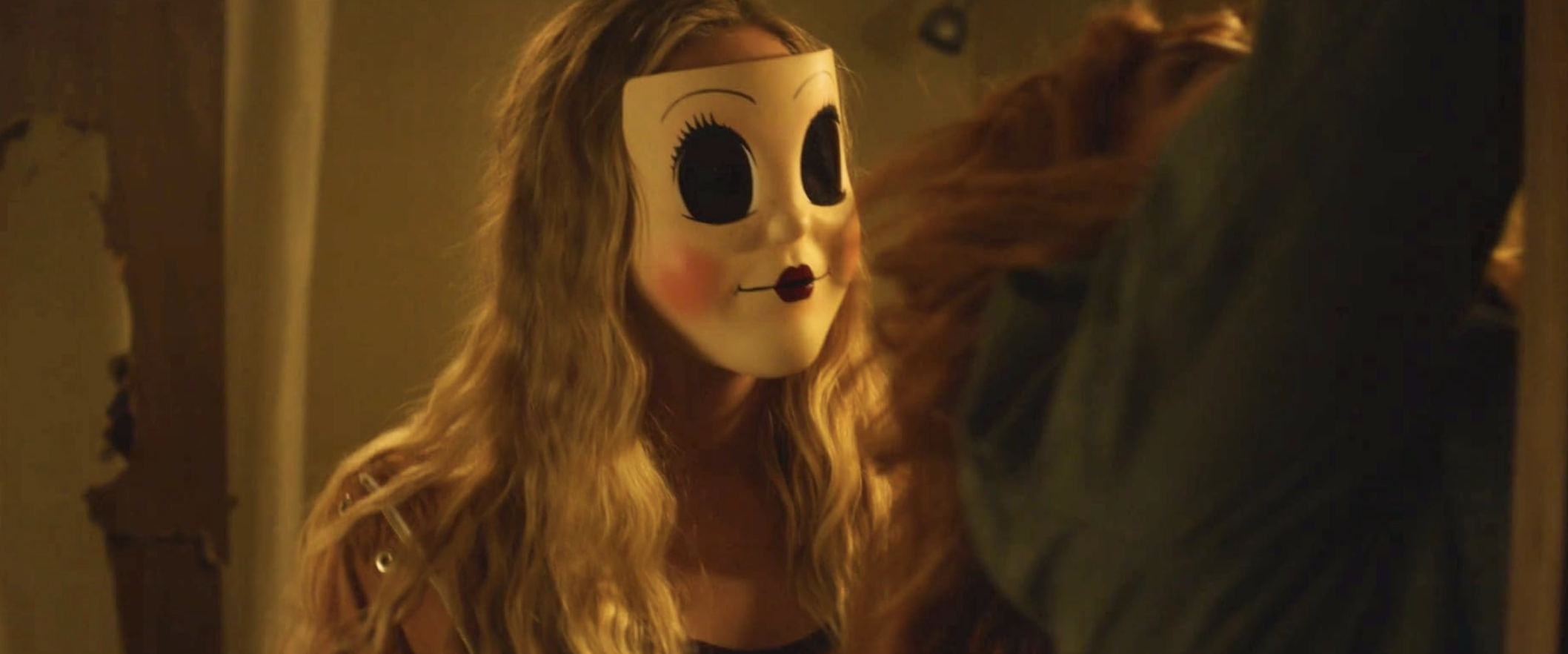
The Dollface Mask
Though they excel at setting the scene for terror, both women use their appearance as a powerful weapon. Each wearing masks, they embody the empty patriarchal ideals of bygone eras. The blonde Dollface wears a cheerful mask with rosy cheeks, a pencil-thin smile, and large, empty eyes.
Resembling Strawberry Shortcake, this static face brings to mind wholesome innocence and girlish perfection. First introduced on a greeting card in 1972, she is a children’s character inspired by her namesake desert. The line has since expanded to include a multitude of feminized characters each referencing a different baked treat. Though the character herself is a child, Strawberry Shortcake was born into a world grappling with second-wave feminism. Record numbers of women began entering the workforce and filing for divorce, destabilizing the nuclear family that had dominated domestic culture. This innocent character could be seen as a symbol of ladylike simplicity, honoring days spent in the kitchen baking pastries from scratch.
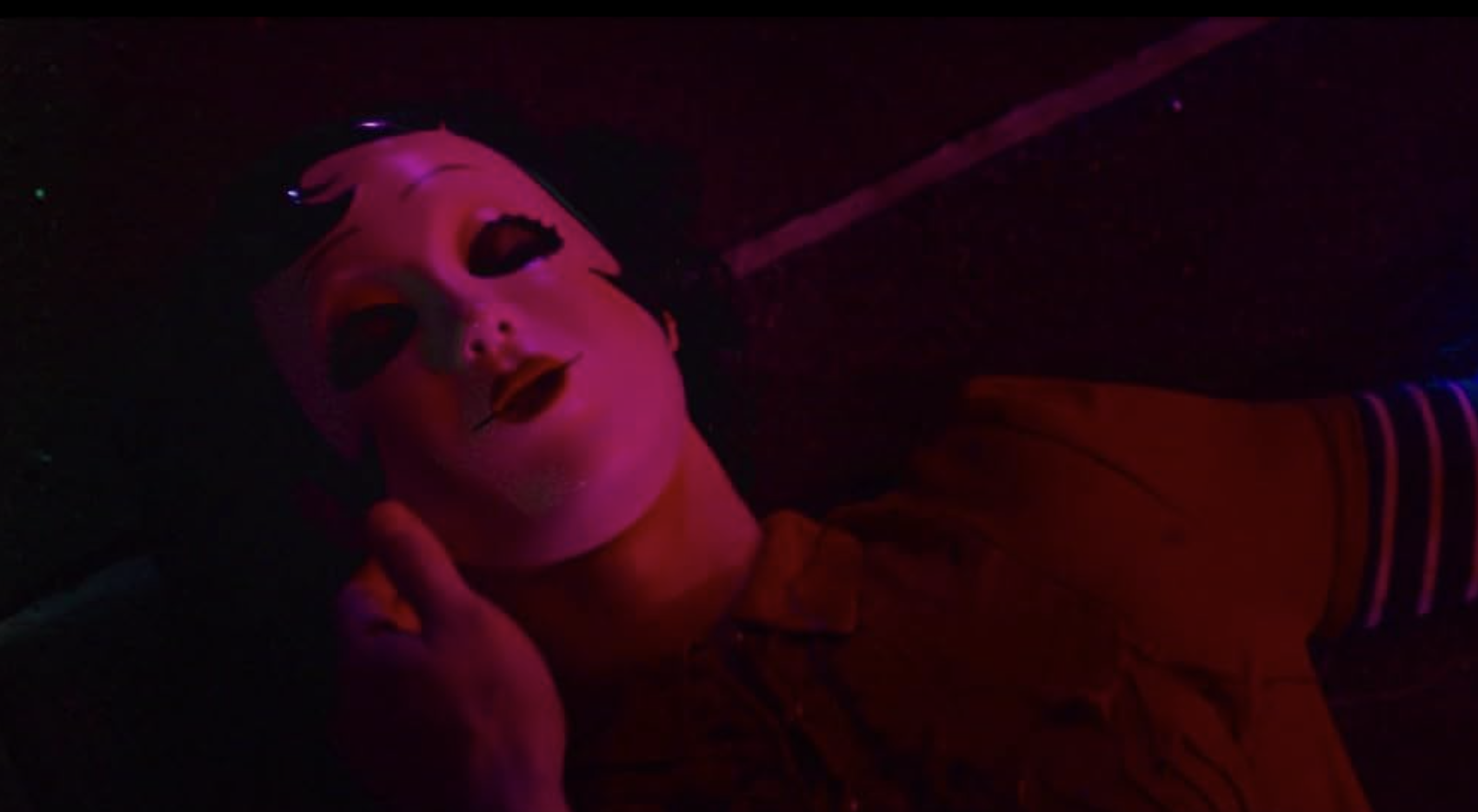
The Pin-Up Girl Mask
Pin-Up Girl stems from the opposite end of this feminine spectrum. Originating from porn-adjacent images from the 1940s, she is a seductive vamp often seen partially clothed in posters lining the walls of male-dominated spaces. With short, brunette hair and heavily lined eyes, this mask presents a sexualized woman unencumbered by domestic responsibility. This carefree Pin-Up Girl is voluptuous and teasing—the idealized object of male desire and a dehumanized vision of the female body. While opinions vary about feminist layers hidden within this perplexing archetype, she exists as a counterpoint to the wholesome Strawberry Shortcake who exerts her limited power in the domestic sphere.
If their masks evoke dated understandings of female agency, their partner embodies a faceless patriarchy. Rather than a store-bought mask, the Man has cut a burlap sack to hide his face with a heavy black line drawn on the front to indicate a non-committal smile. Paired with a brown suit and tie, the overall effect is a beleaguered husband coming home from work. His signature ax is a symbol of male domination, hinting at the classic huntsman and the traditionally male task of splitting wood for the hearth.
In contrast to the women’s iconic personas, this mask seems designed to erase personality. The suit is all we need to imply authority and power. Combined, the Strangers become a hellish nuclear family of their own: a male leader accompanied by opposing female personas. They are Madonna and whore united by a murderous man. The unification of these opposing archetypes creates a destabilizing force that further terrifies victims and the audience alike.
Their Victims
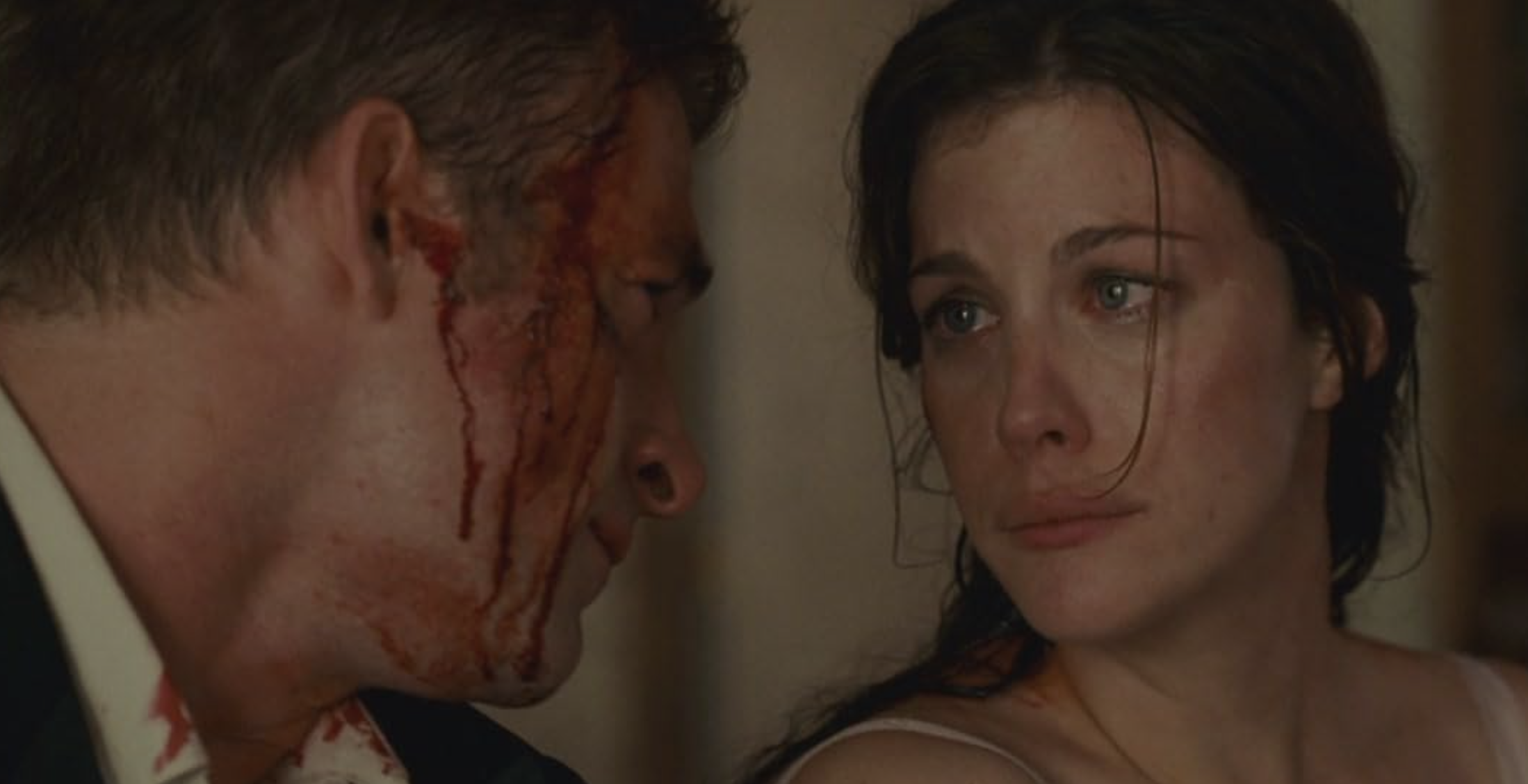
If the Strangers themselves represent stereotypical visions of femininity, their victims embody the reality. Kristen, Cindy, and Kinsey all struggle to define themselves in a patriarchal world personified by the haunting faces of the attacking women.
We meet Kristen in a bridesmaid’s dress with tears in her eyes. Though still wearing the attire of domestic commitment, she has just rejected James’s proposal. We don’t learn much about this couple and their problems, but we get the sense that she has wounded her boyfriend by refusing to be his wife. Midway through the evening, Kristen tries on the ring only to find that it has become stuck on her finger. James notices she is wearing it when they are moments from death.
Combined with the return of her bridesmaid dress, this revelation has the effect of recanting her rejection and accepting his proposal. She alternately professes her love and pleads for their lives while James sits next to her in silence. Kristen’s solo attempts to avert disaster imply that she is the one who has transgressed by refusing to be a wife and now she must beg to restore order in the home.
By patriarchal standards, Cindy could be seen in a similar light. Her child has transgressed and they are on a road trip to deposit her at boarding school. Turned out of her family home, Kinsey is a wayward daughter rejecting traditional gender norms of submissive compliance. In a tense conversation while still on the road, Cindy hints at trouble in her own youth and worries that Kinsey may be following a similar path. In typical teenage fashion, the combative daughter responds by implying that the family wishes she had never been born. Though it ends in heartbreak, Dollface’s attack proves Cindy’s devotion. When the masked Stranger ambushes mother and daughter, Cindy immediately puts herself between Kinsey and the knife-wielding woman. Moments later, she will die from stab wounds endured while helping her daughter escape.
Their Motive
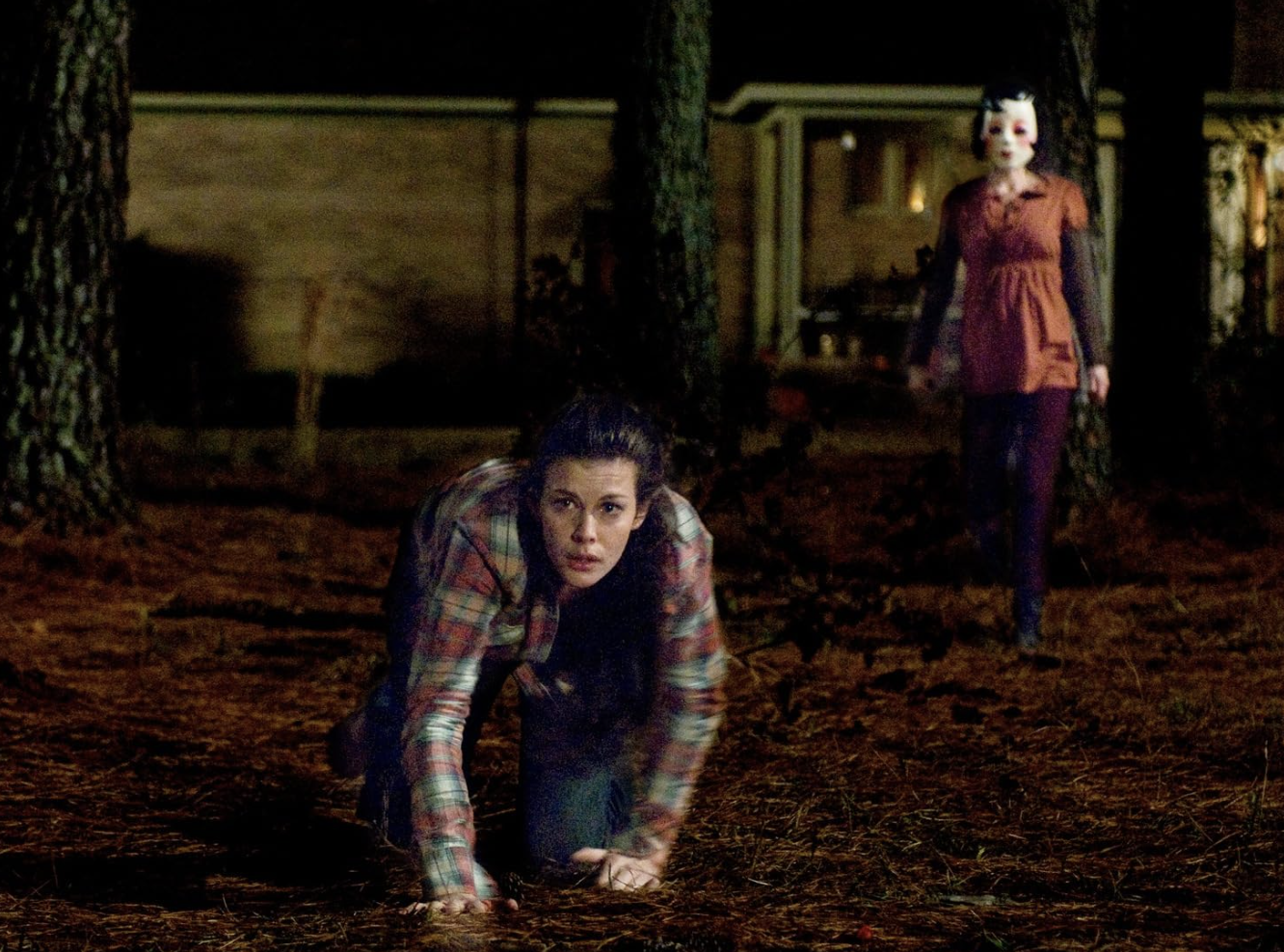
Perhaps the scariest element of the Strangers’ actions is their shocking lack of reason. Embodying the horror of truly random violence, they kill for the simple joy of causing pain. After a long and harrowing night, Bertino concludes his film on a sunny morning. Pin-Up Girl opens the drapes to let in the light and one by one, the Strangers take off their masks. With their faces still hidden from the camera, they reveal their identities to their exhausted captives. Perhaps hoping to delay the inevitable or simply trying to understand, Kristen begs to know why. “Because you were home,” Dollface answers.
There is no reason for their madness and nothing Kristen could have done to protect herself. This answer is chilling in its simplicity, but shifts the blame to the doomed couple. Analyzing the Strangers’ horrific actions, we could reframe this statement to say, “because we wanted to kill you.” With this stark honesty and lack of pretext, Dollface is rejecting the feminine standard of compassionate caregiving and indulging a masculinized urge to murder and destroy.
Dollface gives a similar answer in Roberts’ film. After gaining the upper hand, Kinsey shoots the blond attacker and pulls her mask off as she bleeds in the road. The traumatized teen is shocked to find that beneath this soulless plastic face is a girl her own age. When Kinsey asks, “Why are you doing this,” Dollface responds with a maddening, “Why not?” Outraged at the suffering these teens have caused for something so simple as curiosity and boredom, Kinsey wastes no time ending Dollface’s life. Once an outcast, she has become the sole survivor and avenged the destruction of her own nuclear family, restoring order where Kristen could not.
Their Legacy
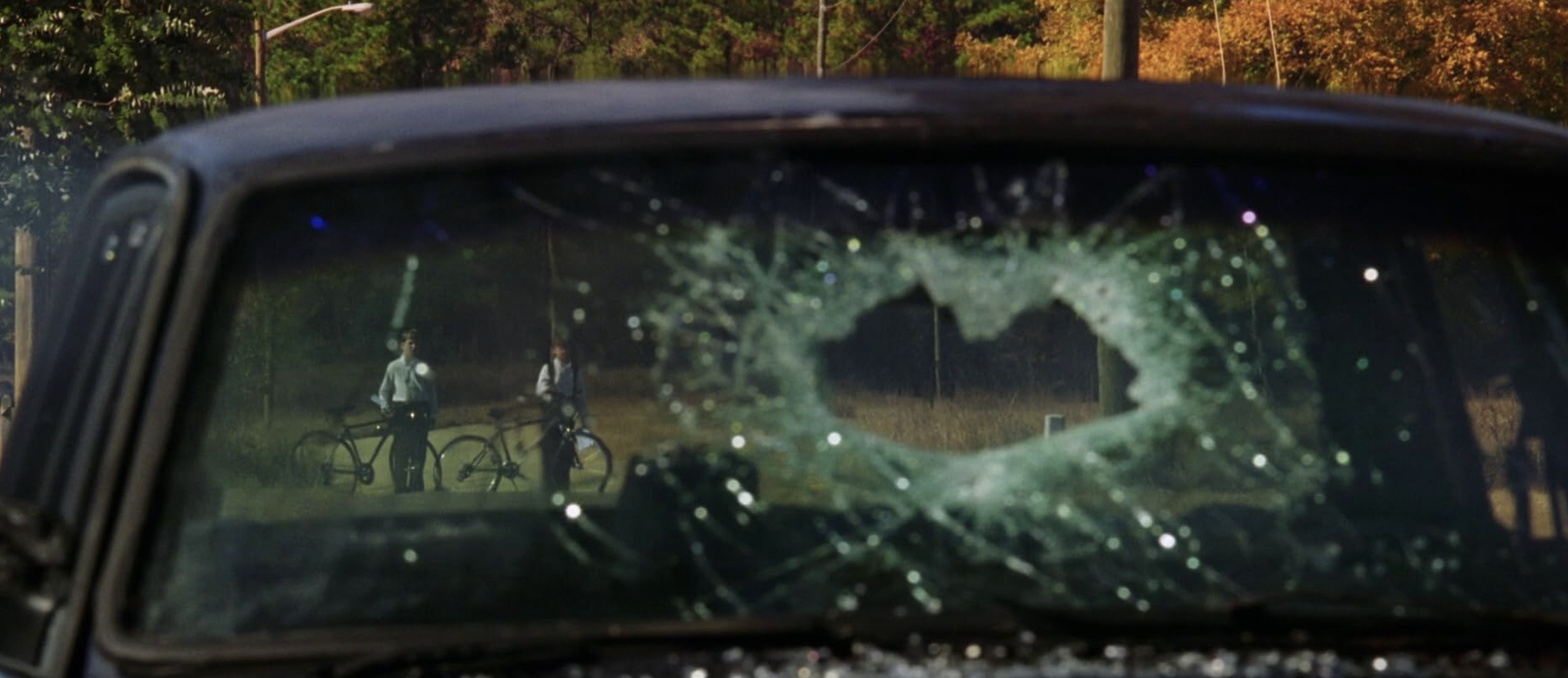
A final scene in the original film sees the Strangers escaping without repercussions. Leaving James and Kristen for dead, they simply climb in the truck and drive away. On the road, they encounter two boys walking their bikes. Dollface approaches these children and asks for one of the religious pamphlets they’re distributing. The boy asks if she’s a sinner and Dollface responds with a chilling, “sometimes”. Her face still hidden from the camera, she gets back in the truck and reenters the world. This frightening answer implies that while we’ve seen Dollface commit atrocious sins, she has a life outside of this murderous hobby. What kind of mask does she wear in her everyday life and how does she hide her sinister truth from the people she encounters on a daily basis?
Though admittedly frightening, this nuanced answer is inherently feminist. In reality, women do sometimes sin. As full human beings, women are capable of acts that are evil, virtuous, or somewhere in between. Kristen, Cindy, and Kinsey embody this female complexity contrasted by their attackers who wear the static faces of generations past. Pin-Up Girl and Dollface have abandoned their humanity in order to adopt a persona of female limitation, but they hide behind these archetypes to commit distinctly non-feminine acts. The masks not only hide their identities, they create an illusion of compliance and point to the Man as the dominant attacker. However, this interaction with the boys on the bikes tells us the women are just as invested in these terrifying crimes. They are female sinners using reductive ideals and damaging stereotypes to attack other women and burn it all down.
Categorized:Editorials

